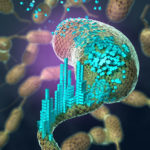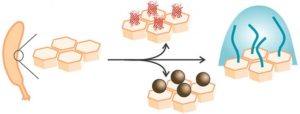
Taking their cue from Nature, Berkeley Lab researchers have engineered living cells to act as a starting point, or “scaffold,” for the self-assembly of composite materials. The resulting engineered living materials (ELMs) represent a new class of material that may open the door to advanced applications in bioelectronics, biosensing, and smart materials.
Leading the effort was Caroline Ajo-Franklin, whose lab is part of the Molecular Foundry, a DOE Office of Science User Facility, and who holds a joint appointment in the Molecular Biophysics and Integrated Bioimaging (MBIB) Division. A study describing the work was recently published in ACS Synthetic Biology.
Both natural structures and the ELMs they inspire are comprised of hierarchical patterns of uniformly sized building blocks—each of which is itself made up of smaller units. To control the self-assembly of these types of structures on the surface of living cells, Ajo-Franklin and her team took advantage of surface-layer proteins to form ordered, sheet-like structures on the surface of many microbes.

“We built a set of bacteria that can irreversibly attach a variety of hard or soft materials like biopolymers or semiconducting nanoparticles to the cell surface without damaging the cells,” said Marimikel Charrier, a scientific engineering associate in Ajo-Franklin’s group and first author of the study.
Ajo-Franklin is spearheading the Lab-wide Genetically Encoded Composites (GECO) strategic initiative.
Read more in the Berkeley Lab News Center.



